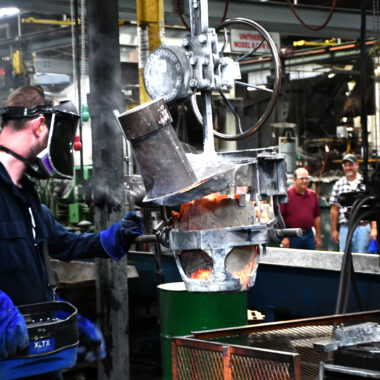The Ultimate Aluminum Casting Handbook: Step-by-Step Instructions for Success

Safety And Security Precautions for Aluminum Spreading

Moreover, preserving a clean work space complimentary of clutter can protect against tripping dangers and facilitate the activity of personnel during casting processes. aluminum casting illinois. Correct training in handling liquified aluminum and operating spreading devices is vital to lessen the danger of injuries and crashes. Routine devices maintenance and assessment ought to be conducted to determine and rectify any kind of possible safety and security threats quickly
Establishing Up Your Light Weight Aluminum Casting Work Area
Establishing a reliable and secure work space for light weight aluminum spreading is critical for making sure smooth procedures and decreasing possible hazards. Before setting up your work space, ensure that it is well-ventilated to avoid the build-up of hazardous fumes generated during the casting process. It is important to have actually a marked location for each stage of the spreading procedure, such as pattern production, mold prep work, and metal putting, to improve operations and protect against cross-contamination.
Picking the Right Aluminum Alloy
To ensure optimal spreading causes your well-organized and safety-focused work area, selecting the proper aluminum alloy is extremely important. Different aluminum alloys provide different qualities such as strength, resilience, warmth resistance, and machinability. The choice of alloy depends on the details needs of your spreading task.
One frequently utilized aluminum alloy for spreading is A356. This alloy shows exceptional fluidity, making it ideal for elaborate castings with thin wall surfaces. A356 also has great corrosion resistance and mechanical homes, making it ideal for a wide variety of applications.
If higher toughness is needed, 7075 aluminum alloy is a popular choice. Known for its high strength-to-weight proportion, 7075 is usually made use of in applications where strength is important, such as aerospace elements.
For projects that entail high-temperature settings, 319 light weight aluminum alloy is an excellent choice as a result of its exceptional thermal conductivity and resistance to thermal fracturing.

Step-by-Step Light Weight Aluminum Casting Refine
Starting the aluminum spreading process includes meticulous prep work and adherence to an accurate series of actions to ensure the manufacturing of high-quality spreadings. The very first step is pattern production, where a reproduction of the last item is made from plastic, metal, or wood. This pattern is after that utilized to develop the mold and mildew, which can be constructed from products like sand or plaster. Once the mold is prepared, it is time to thaw the aluminum in a furnace at temperature levels going beyond 1200 ° F.
After reaching the desired temperature level, the liquified aluminum is put into the mold cavity. This step needs caution and precision to stay clear of issues in the final casting. The aluminum is delegated solidify and cool inside the mold prior to it is eliminated for finishing. Post-processing methods such as grinding, fining sand, and warmth treatment might be utilized to attain the preferred shape, surface finish, and mechanical properties.
Throughout the whole procedure, mindful tracking and top quality control actions should be carried out to ensure the final aluminum casting satisfies the needed requirements and standards.
Tips for Improving Your Casting Strategy
In refining your aluminum spreading method, thorough focus to information and adherence to specific actions are paramount to making sure the manufacturing of top notch spreadings. One crucial pointer for developing your spreading method is to carefully prepare the mold and mildew and ensure it is clean and appropriately coated with a release agent to assist in the simple elimination of the casting. Additionally, keeping the aluminum at the right temperature level throughout the casting procedure is essential for achieving ideal flow and lowering the threat of flaws. One more tip is to pour the molten aluminum gradually and progressively right into the mold and mildew to stop air entrapment and make certain a smooth fill. It is likewise vital to allow sufficient time for the aluminum to solidify totally prior to getting rid of the spreading from the mold. Checking the spreading for any type of blemishes and making required changes to the process will assist you improve and excellent dig this your light weight aluminum spreading strategy over time.
Final Thought
To conclude, adhering to appropriate safety preventative measures, setting up a suitable office, selecting the right light weight aluminum alloy, and carefully following the step-by-step spreading procedure are critical for successful light weight aluminum casting. By paying interest to these vital elements and incorporating tips to fine-tune your technique, you can accomplish superb results in your aluminum casting jobs.
From safety and security precautions to developing casting strategies, this guidebook serves as a sign of understanding for those venturing right into the world of light weight aluminum casting.
Starting pop over to these guys the aluminum spreading process includes meticulous preparation and adherence to a precise collection of actions to guarantee the manufacturing of high-grade spreadings.In refining your light weight aluminum casting method, meticulous focus to detail and adherence to precise actions are critical to making certain the production of high-grade castings. One crucial idea for developing your casting technique is to very carefully prepare the mold and mildew and guarantee it is clean and effectively covered with a release representative to aid in the easy elimination of the spreading. Evaluating the spreading for any type of flaws and making essential changes to the procedure will aid he said you boost and best your light weight aluminum casting method over time.
Comments on “Professionals in Aluminum Casting Illinois: Boost Your Manufacturing”